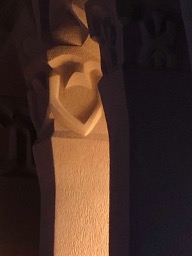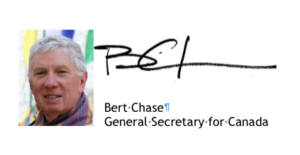24 Oct From the World Society: On Boundaries and Thresholds
With the crisp freshness of frost and the scent of fallen leaves in the air we return once more to this special time in the year’s cycle. Looking out over the landscape we can be moved by the luminous golds and fiery reds of our maple trees as they blanket the earth with their five-pointed stars. We hear the call of geese on their migrations. We can picture great rivers of caribou flowing across the tundra, the southward journeying of whales along our coasts.
We can also look out onto a parallel world, the world that humanity has learned to imagine. We see invisible lines beneath the unbroken blanket of falling leaves. We perceive borders and boundaries that are imperceptible to the frenzied squirrel, the wings of geese, the rivers of caribou. We cultivate a way of seeing that would parcel nature, that would sever what is whole into imperceptible entities – entities that we cannot see or touch – invisible realities that we invest with deep significance. We feel ourselves attached to, identified by, these invisible lines, deeply concerned about our relationships to these abstract incisions on the earth. We marvel that these divides have no effect on nature who so freely shares her bounty across boundaries, across borders, with indifference. The deepening white of winter advances without concern for our imagined demarcations.
Nature’s innocence affects us deeply. The sureness with which she aligns herself with the movements of the year; following the receding sun, orienting herself to the movement of the zodiac across the sky can leave us disorientated by her indifference to what we hold as essential.
Near the end of his life, during what was to be the last of his Michaelmas conferences, Rudolf Steiner spoke of this remarkable autumn process to his Viennese friends. He describes how over the past 400 years we have cultivated this ‘dissecting’ view of the world. We turn our discriminating gaze onto our surroundings and see definitions, demarcations, rather than fullness and wholeness. He describes how we turn to the lily, and with our gaze imprison nature. With a crushing exactness we classify the lily’s species and genus, and yet in doing so we separate ourselves from her essential being.
As we turn this disintegrating conceptualization onto the world we can easily miss that we simultaneously direct these same analytical forces against ourselves. We have cultivated a refined capacity to lacerate the world, and in so doing we pull apart our own humanity. We have learned to embed into our souls this ‘bordering’ of the other. We have cultivated a way of orienting ourselves to each other based on these invisible lines, invisible demarcations. These same walls imprison us.
Against this world view we can be deeply moved by the model of Rudolf Steiner who awakens a different world perception. An anthroposophical perception transforms boundaries into thresholds. Anthroposophy bridges, makes doorways of separations.
As Europe descended into the terrible chaos of separateness that was the First World War, in Dornach an alternative intentionality was being cultivated. Individuals came together from a score of these warring states to meet the world with completely different will forces. Out of a common vision of a Michaelic humanity they created while the world around them disintegrated. In a world descending into ashes they built, bringing the Goetheanum into being. That they wove into the soul fabric of Europe forces dedicated to a common creation in the midst of destruction is of profound significance. With their powerful will activity, with their deeds, they acted beyond separations. They lived anthroposophy’s bridging power.
We again live in a time when powerful forces are at work to overwhelm our perceptions, awakening fear and anxiety, in order to harden these boundary making processes, processes that in turn imprison us.
In the Michaelmas lectures given in Vienna Rudolf Steiner asks us to actively overcome the limitations of our current world conceptions. To go beyond the tyranny of boundaries and enter into threshold making processes with our fellow human beings, with nature herself. As we cultivate these capacities our world becomes ever more transparent. The essence of what we carry within ourselves becomes part of our shared soul environment. This is to live anthroposophy. All that we carry as the gift of anthroposophy is given to prepare us for this future oriented task. Hindering forces want to rob us of this gift.
In the urgency of our time can we perceive what the world is asking of us? Cultivate soul doorways, build spiritual bridges. This is the living of anthroposophy that in its practice transforms the soul geography that all of nature, and all of humanity, shares.

